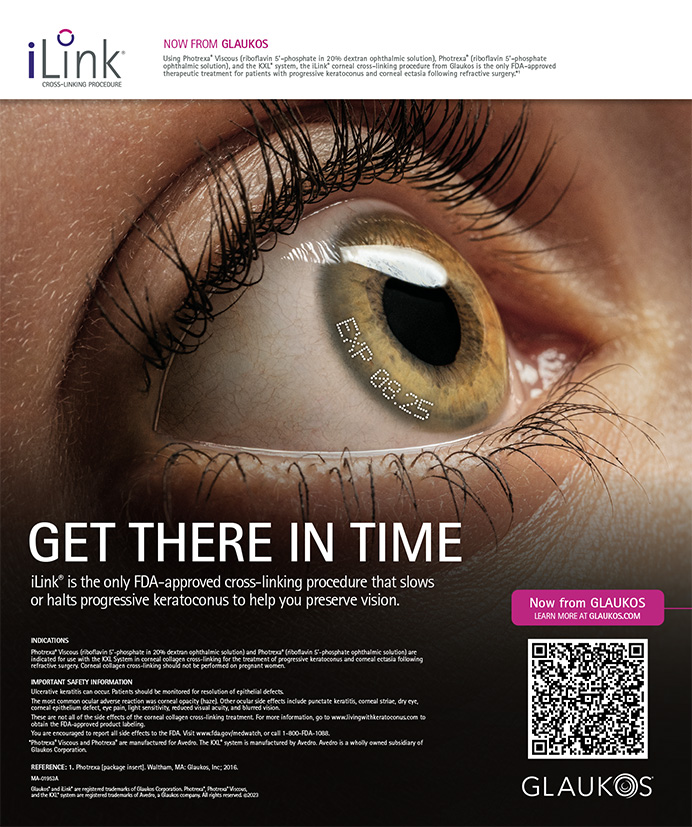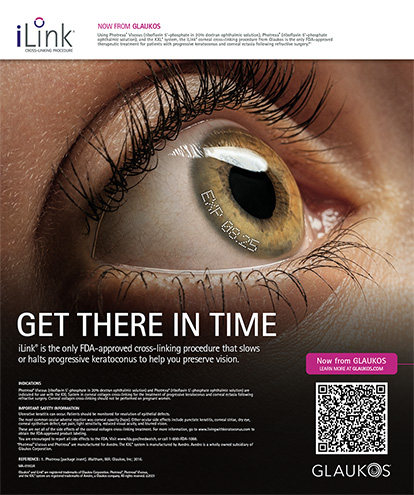I began mixing the ReZoom IOL (Advanced Medical Optics, Inc., Santa Ana, CA) and AcrySof Restor IOL (Alcon Laboratories, Inc., Fort Worth, TX), because my patients were highly dissatisfied with the bilateral implantation of the latter. Most other US surgeons did not share my initial experience. What accounts for these differences in results?
CATARACT SURGERY VERSUS REFRACTIVE LENS EXCHANGE
The typical US surgeon using the AcrySof Restor lens treats more patients with cataract surgery than refractive lens exchange (a ratio greater than 20:1). These patient groups' expectations for their postoperative vision are extremely different (Table 1). The AcrySof Restor FDA study enrolled only cataract surgery patients who paid nothing for the bilateral implantation of the lens.1 The criteria for success with a 75-year-old patient with a dense, nuclear sclerotic cataract versus a 50-year-old baby boomer undergoing refractive lens exchange are very dissimilar. The AcrySof Restor FDA study thus revealed little about how that IOL would perform in the 40- to 60-year-old refractive lens exchange patient.
ELECTIVE REFRACTIVE SURGERY AND PATIENTS' EXPECTATIONS
Patients Want What They Pay for
The original targeted market for these presbyopia-correcting IOLs was not cataract surgery patients but precataract presbyopes, but all patients are paying out of pocket for these lenses. Now these procedures are officially considered refractive surgeries, and an 80 success rate for any form of refractive surgery is unacceptable. Imagine telling LASIK patients that they have an 80 chance of functioning without glasses after a procedure that costs $3,000 to $5,000. The perception of visual improvement achieved by cataract patients averaging 70 years of age is dominated by the results associated with the extraction of the cataract, irrespective of the type of IOL implanted.
My Experience With the AcrySof Restor IOL
After hearing many positive presentations on the AcrySof Restor lens at the 2004 ESCRS meeting in Paris, I began wait-listing my multifocal IOL patients until the this IOL became available in the US on June 1, 2005. I quickly established a cohort of 55 bilateral AcrySof Restor recipients in a 3-month period.2 Sixty-three percent underwent elective refractive lens exchange surgeries.
Seventeen of my 55 AcrySof Restor patients complained of a lack of intermediate vision, and one in three of my refractive lens exchange patients voicing this disappointment. It became apparent to me that baby boomers and younger cataract surgery patients would not tolerate the absence of functional intermediate vision.
During the same time period, I evaluated several patients who had received a unilateral Array lens (Advanced Medical Optics, Inc., Santa Ana, CA) and desired an IOL in their fellow eye in hopes of achieving sharper reading vision without additional halos. I implanted the AcrySof Restor lens in the fellow eyes of five such patients, and they were extremely happy and completely free of spectacles postoperatively. I therefore decided to explore combining the ReZoom and AcrySof Restor IOLs, because the former represents an upgrade of the Array lens.
MIXING THE REZOOM WITH THE ACRYSOF RESTOR
The first 110 patients in whom I implanted the combination of ReZoom and AcrySof Restor lenses achieved statistically and clinically better intermediate vision than those in whom I had bilaterally implanted the AcrySof Restor lens. The ReZoom/AcrySof Restor patients achieved J2.44 versus J3.60 for the bilateral AcrySof Restor patients, and none of the former group spontaneously complained about his intermediate vision. Moreover, my ReZoom/AcrySof Restor patients seemed to have the "wow" factor that is frequently observed in LASIK patients. In comparison, even my successful bilateral AcrySof Restor patients often seemed relatively "underwhelmed."
There were no statistically significant differences with regard to bilateral near vision between the two groups. The ReZoom/AcrySof Restor patients, however, frequently reported a more comfortable reading distance compared with the bilateral AcrySof Restor patients, who often thought their near point of focus was too close. Additionally, as Akaishi and Fabri3 reported at the World Cornea Congress last year, I have observed subtle but significant losses in patients' BCVA and uncorrected distance visual acuity with the AcrySof Restor lens.
WAXY VISION
I recently reported on a group of patients4 with a severe form of waxy vision, which I call Vaseline vision dysphotopsia (Vaseline; Unilever, PLC, London, United Kingdom). I diagnosed the problem in 13 of 300 eyes (4.33) in which I implanted the AcrySof Restor lens, nine of which required explantation. The symptoms of Vaseline vision dysphotopsia are unique in that they (1) present almost immediately after the IOL's implantation, (2) are constant rather than intermittent, (3) are not dependent on a point source of light, (4) do not decrease with neuroadaptation, (5) appear to be psychologically draining as much as visually dysfunctional, and (6) are only relieved by the lens' explantation.
Nevertheless, my experience with multifocal IOLs has led me to two core conclusions. The first is that mixing a refractive with a diffractive multifocal IOL will greatly satisfy patients and produce a high level of spectacle independence. The second is that the AcrySof Restor IOL is not the optimal diffractive lens for the refractive IOL/diffractive IOL combination.
CONCLUSION
High levels of success with presbyopia-correcting IOLs entail selecting the proper patients and effectively setting their expectations before surgery. The preoperative examination should confirm that they have full visual potential, with special attention paid to the cornea and the retina. Surgeons should also continually upgrade their skills at phacoemulsification and the correction of residual refractive errors such as corneal astigmatism. Although optimal IOL selection is a critical element, it is still only one of many essential building blocks (see The 10 Ps) necessary for producing a patient satisfied with presbyopia-correcting IOLs.
Akaishi and Fabri3 reported superior reading speeds, greater pupillary independence, better-quality distance vision, and a lesser incidence of halos and glare with a combination of the ReZoom lens and the aspheric Tecnis Multifocal IOL (not approved in the US; Advanced Medical Optics, Inc.) compared with the ReZoom/AcrySof Restor combination. The diffractive rings of the Tecnis Multifocal IOL are spread throughout the lens' entire optic, whereas all of the rings are located within the central 3.6 mm of the AcrySof Restor lens' optic. It may be that the centralization of the rings produces the waxy vision and Vaseline vision dysphotopsia associated with the latter IOL. There have been no reports of waxy vision with the Tecnis Multifocal IOL. I therefore believe that combining the ReZoom and Tecnis Multifocal IOLs will be the optimal approach to presbyopic correction among patients undergoing cataract surgery and refractive lens exchange once the latter lens is approved by the FDA.
Frank A. Bucci, Jr, MD, is Medical Director of Bucci Laser Vision Institute in Wilkes Barre, Pennsylvania. He acknowledged no financial interest in the products or companies mentioned herein. Dr. Bucci may be reached at (570) 825-5949; buccivision@aol.com.


